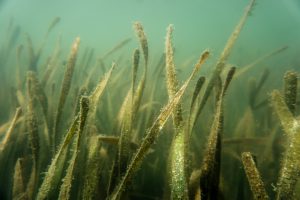Scientists from the University of Florida, Auburn University and the Tampa Bay Estuary Program are using artificial intelligence technology to identify damaged seagrass beds in Tampa Bay – and so far, they’ve found almost 24,000 scars.
That’s about one scar for every four registered boats in Hillsborough and Pinellas Counties.
Final results from the study are not expected until sometime in 2023, but so far, scientists show wounded seagrass widespread in Tampa Bay and the east coast of Pinellas County. Scarring was particularly heavy in lower Tampa Bay, especially between the Skyway Bridge and Fort De Soto, Cockroach Bay south of Ruskin and north of the Robinson Preserve in Manatee County.
“These findings are important because they identify hot spots for seagrass scarring and areas where education and outreach can be applied to minimize damage,” said Quenton Tuckett, a research assistant scientist at the UF/IFAS Tropical Aquaculture Lab (TAL) in Ruskin.

Tuckett is working on the study, along with Katelyn Lawson and Josh Patterson, a faculty member at TAL, who’s also a UF/IFAS associate professor of fisheries and aquatic sciences in the School of Forest, Fisheries, and Geomatics Sciences and a Florida Sea Grant-affiliated researcher.
“Seagrass is a critical habitat in Tampa Bay and is considered an indicator of a healthy estuary. It stabilizes sediment, reduces shoreline erosion, sequesters carbon and provides food and habitat for a variety of fish and wildlife at important times during their lives,” said Sheila Scolaro, the community programs scientist with the Tampa Bay Estuary Program.
But because it grows in shallow water, seagrass is also prone to damage by boat propellers.
When vessels travel in shallow water over seagrass meadows, the propeller, transom and hull of a boat can cut through the stems and roots and into the sediment. This leaves a deep, highly visible depression. Scars can then spread through erosion and scouring, magnifying the damage. Scouring comes about when waves and currents expand the scar.
That’s why scientists are trying not only to quantify the scars but determine the extent of damage to seagrass. To do that for this research project, they used machine learning and computer software.
“The research shows another way we can use machine learning to solve everyday problems,” Tuckett said. “Object detection can be thought of as computer vision, where the program is trained to identify objects — seagrass cars in this case — much like it would be used in autonomous vehicles and video surveillance.”
Without machine learning, scientists would go through the laborious process of digitally tracing the scars — a process which could take months to complete for an area as large as Tampa Bay.
Additionally, the process is automated and repeatable.
The process allows scientists to identify damage, based on images that they and other scientists will use in the future, said Lawson, a landscape ecologist at Auburn and a doctoral graduate of the UF/IFAS College of Agricultural and Life Sciences
Tuckett offers some tips for boaters to ease seagrass scarring:
- Know the area. Use navigational aids such as channel markers and maps to avoid shallow water.
- Know when tides will be high and low.
- Slow the boat and lift the propeller when you’re approaching shallow areas or when you are unsure of the depth.
- Know your vessel and become familiar with the draft — the distance between the surface of the water and the deepest point on the boat.
- Wear polarized sunglasses to reduce glare to be better able to spot shallow areas and seagrass.
“Unlike many complex environmental challenges, however, propeller scarring in Tampa Bay is well within our ability to solve,” Tuckett said. “Boaters can use simple practices to help eliminate seagrass scars while also preventing damage to their boat.”
You can click here to find out more about seagrass scarring. The supplemental video above from Florida Sea Grant shows how Sea Grant is helping monitor and preserve seagrass in Florida. Florida Sea Grant’s citizen science program Eyes on Seagrass utilizes volunteers to monitor the health and abundance of seagrasses across the state. Join Florida Sea Grant agents and specialists as they share best practices in the field and see what it’s like to be a citizen scientist.
###
ABOUT UF/IFAS
The mission of the University of Florida Institute of Food and Agricultural Sciences (UF/IFAS) is to develop knowledge relevant to agricultural, human and natural resources and to make that knowledge available to sustain and enhance the quality of human life. With more than a dozen research facilities, 67 county Extension offices, and award-winning students and faculty in the UF College of Agricultural and Life Sciences, UF/IFAS brings science-based solutions to the state’s agricultural and natural resources industries, and all Florida residents.
About AI at UF
The University of Florida is making artificial intelligence the centerpiece of a major, long-term initiative that combines world-class research infrastructure, cutting-edge research and a transformational approach to curriculum. UF is home the most powerful, university-owned supercomputer in the nation, according to 2021 rankings by TOP500, contributing to innovative research and education opportunities.
 1
1
